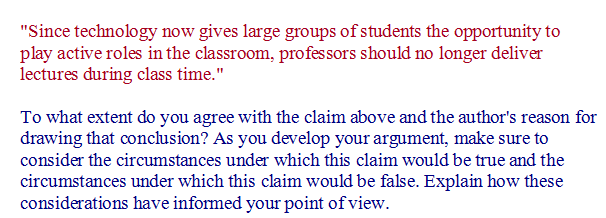12. Sample "Analyze an Issue" Essay
Sample "Analyze an Issue" Essay

Lectures are rarely a student’s ideal form of learning, but they were once an efficient way for experts to share an omnibus of information, theories, or in-depth thinking with hundreds of students at a time. Now that recording information as a video clip or blog post is simple, lectures may seem obsolete and less effective than online learning. Before dismissing them, however, one needs to ask if they have any potential features that an online video, post, or tutorial lacks. Can in-person talks allow a speaker to engage and respond to an audience in ways that a screen cannot? If so, there is no reason for one to completely replace the other; however, many lectures can still be enhanced by technology.
The Internet has given more students access to an expert teaching. It also provides many different kinds of opportunities for users to apply the skills that they have learned and/or respond to the content of each lesson. Rather than reaching hundreds of students enrolled in one class, a lecture can now reach billions of people when posted online. That gives anyone with Internet access the means to learn from a renowned expert in a field. Each student can also choose to work through an online lesson in the way that works best for him/her. They can replay a part as many times as they need to and are often able to submit questions as well. Apps, websites, and software programs also encourage student interaction. The features require more engagement than the slideshows and Power Points commonly used in lectures. When considering these benefits, technology not only seems more efficient than lectures, but it also allows each user to create a personalized learning experience.
Before banning lectures, however, the value of seeing a presentation delivered in person needs to be examined. Lectures give each audience member the opportunity to see an expert model in-depth thinking on a topic, and students often have the opportunity to ask that expert questions about the topic just after the lecture or during office hours. A student is then more likely to receive a direct and immediate reply from the speaker, rather than a possible reply through a post on a social networking site or email. At a live lecture, a speaker can also detect and respond to the needs of an audience. He/she can often perceive confusion or concern within an audience and then take time to clarify a point or further explain a position. The most memorable lectures often include interactive experiences that a screen cannot deliver: speakers may pass out artifacts for the students to study, and one beloved law professor even staged a crime for his students to witness during his lecture. Watching that scene through a screen would provide a safe distance from the action and dull its effect. Though a live lecture may not be as efficient as technology-based learning, it is far more engaging when an instructor turns it into the kind of in-person, interactive experience that computers cannot provide.
Rather than choosing one form of learning over the other, lecturers can now use technology to encourage students to actively participate in class, rather than be passive audience members. Borrowing a technique from game shows, some instructors now provide students with clickers or a computer program that lets them register their responses to a question or poll on a screen as the professor speaks. That opportunity increases engagement and can motivate students to pay attention to the content. Lecturers can also set aside the slideshows in order to explore a topic through multiple modes, including images, music, and animation. If they choose to do so, instructors are also able to post recordings of their lectures online, giving students the benefits of interesting live and online learning experiences. As it has done with “tablets,” technology is now popularizing and transforming another archaic form of communication.
Lectures that do no more than a textbook or speech can accomplish should no longer be delivered. Computer programs, websites, and applications give students the opportunity to learn the same content through multiple modes and at their own paces. Those vapid recitations, however, do not represent the whole medium. A great speaker and instructor can use the format to engage students in ways that a computer cannot by responding to their concerns, questions, and giving them the chance to take part in live learning experiences. Rather than competing with technology, lecturers can use new devices to build a community within a lecture hall and ensure that everyone within that hall has the option to learn that information in the ways that work best for them. While technology can set new standards for lecturers to meet or outdo, it cannot take their place at the podium.